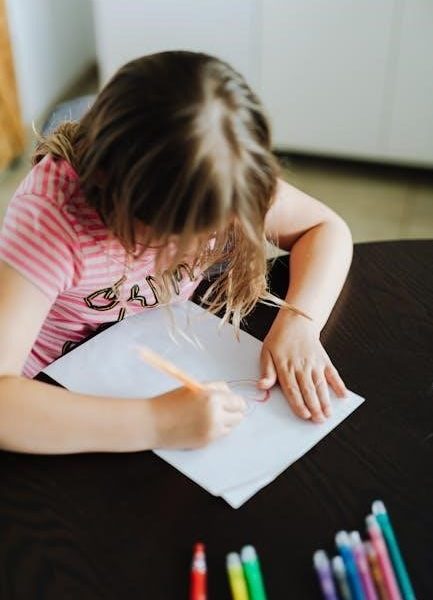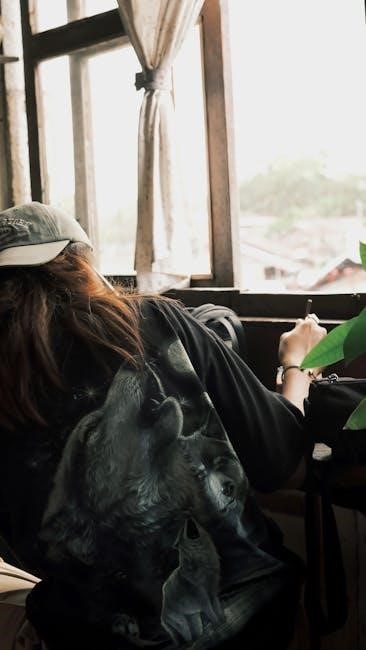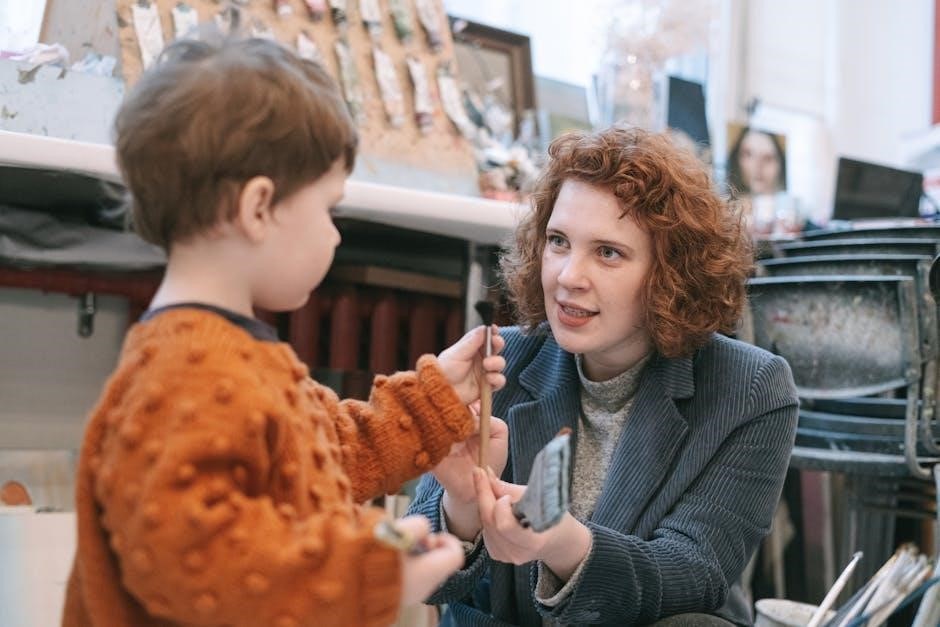
back to back drawing activity pdf
Back-to-Back Drawing Activity PDF: A Comprehensive Guide
This engaging activity enhances communication and teamwork by having pairs sit back-to-back, with one describing an image for the other to draw. It fosters creativity, clarity, and collaboration, perfect for teams, classrooms, and leadership development.
Back-to-Back Drawing is a popular communication and teamwork activity designed to enhance collaboration and understanding between individuals. In this exercise, participants are paired and seated back-to-back, with one person describing an image or drawing, while the other attempts to replicate it based solely on the description. This simple yet effective activity is widely used in classrooms, workplaces, and team-building sessions to foster clear communication, active listening, and creativity. The goal is not to create a perfect drawing but to emphasize the importance of precise instructions and effective interpretation. By removing visual cues, participants must rely on verbal communication, making it an ideal tool for improving interpersonal skills. The activity is versatile, suitable for diverse audiences, and can be adapted to various settings, making it a valuable resource for educators, trainers, and leaders. Its engaging nature ensures that participants remain focused and motivated while learning valuable lessons about collaboration and clarity.
Objectives of the Back-to-Back Drawing Activity
The primary objective of the Back-to-Back Drawing activity is to improve communication skills by emphasizing the importance of clear and precise instructions. By having participants describe and replicate a drawing without visual cues, the exercise highlights the impact of effective verbal communication. Another key goal is to enhance active listening skills, ensuring that participants accurately interpret and execute the given instructions. Additionally, the activity fosters teamwork and collaboration by requiring individuals to work together towards a common objective. It also encourages creativity, as participants must think critically to describe complex shapes or images. Furthermore, the exercise promotes patience and understanding, as it often reveals the challenges of translating visual information into verbal descriptions. Overall, the activity aims to bridge gaps in communication, strengthen interpersonal connections, and provide a fun, engaging way to develop essential life skills. By achieving these objectives, participants gain valuable insights into the power of clear communication in both personal and professional settings, making it a highly effective tool for diverse groups.
Benefits of the Back-to-Back Drawing Exercise
The Back-to-Back Drawing Exercise offers numerous benefits, primarily focusing on enhancing communication and interpersonal skills. It improves clarity and precision in verbal instructions, helping participants learn to convey ideas effectively. Active listening is another key benefit, as the activity requires careful interpretation of descriptions to replicate the drawing accurately. This exercise also fosters teamwork and collaboration, encouraging participants to rely on each other’s strengths. Additionally, it enhances creativity by challenging individuals to think outside the box when describing complex visuals. The activity promotes patience and empathy, as participants understand the difficulties of translating visual information into words. It also highlights the importance of feedback, allowing individuals to refine their communication strategies. By bridging communication gaps, the exercise strengthens relationships and builds trust among participants. Overall, the Back-to-Back Drawing Exercise is a fun and engaging way to develop essential life skills, making it a valuable tool for personal and professional growth. Its simplicity and effectiveness make it suitable for diverse groups, ensuring meaningful outcomes for all involved.
Materials Needed for the Activity
Organizing the Back-to-Back Drawing Activity requires minimal materials, making it accessible and easy to set up for any group size. Each participant needs a blank sheet of paper and a pencil or pen for drawing. Additionally, one member of each pair should have a simple line drawing or image to describe. The images can vary in complexity depending on the group’s skill level and the activity’s goals. A printer is necessary to print the images, and ensuring that each pair has enough space to sit back-to-back is essential for effective communication. Optional materials include erasers for correcting mistakes and colored pencils for more creative expressions. A timer can also be used to add a time constraint, encouraging concise and clear instructions. The PDF guide provides pre-designed images and instructions, making preparation straightforward. With these simple materials, the activity can be conducted efficiently in various settings, such as classrooms, offices, or workshops, ensuring a productive and engaging experience for all participants.

Step-by-Step Instructions for Conducting the Activity
Begin by dividing participants into pairs and having them sit back-to-back to ensure they cannot see each other’s work. Provide each pair with a blank sheet of paper and a pencil or pen. One participant receives a simple line drawing or image to describe, while the other prepares to draw based on the description.
Set a time limit, such as 5-10 minutes, for the describer to explain the image in detail. Encourage clear, concise communication, focusing on shapes, lines, and proportions.
The listener draws based solely on the verbal instructions, without asking questions or clarifying details. This emphasizes the importance of precise communication.
After the time is up, allow participants to compare the original image with the drawn interpretation. This step fosters discussion and reflection on the effectiveness of their communication.
Repeat the activity, switching roles to give both participants a chance to describe and draw. This ensures a balanced experience and deeper understanding of the challenges involved.
Conclude with a group discussion, highlighting key takeaways about communication styles, active listening, and collaboration. Optionally, introduce variations, such as increasing the complexity of the images or shortening the time limit, to enhance the challenge.

Effectiveness in Improving Communication Skills

The back-to-back drawing activity is a powerful tool for enhancing communication skills, fostering clarity, and promoting active listening. By sitting back-to-back, participants rely solely on verbal descriptions, eliminating visual cues. This setup forces individuals to articulate details precisely and listen attentively, making it an ideal exercise for teams, classrooms, and leadership training. The activity reveals how effectively messages are conveyed and received, often highlighting gaps in communication styles. For example, some may realize they overcomplicate instructions, while others may learn to ask clarifying questions. The immediate feedback from comparing the original image with the drawn result provides tangible insights into communication strengths and areas for improvement. This hands-on approach helps participants develop a deeper understanding of the challenges and nuances of clear communication. Over time, it can lead to more effective collaboration and stronger interpersonal connections, making it a valuable addition to any team-building or skills development program.
Role of Back-to-Back Drawing in Team-Building
Back-to-back drawing plays a pivotal role in team-building by fostering collaboration, trust, and mutual understanding among team members. This activity encourages participants to rely on each other’s strengths, with one providing detailed descriptions and the other interpreting and executing the instructions. It breaks down communication barriers and highlights the importance of clear, concise messaging. Teams learn to appreciate the value of active listening and adaptability, as they work together to achieve a common goal. The exercise also promotes problem-solving and creativity, as participants navigate the challenges of translating verbal descriptions into visual representations. By sharing laughter and feedback during the process, teams build stronger bonds and develop a sense of camaraderie. This interactive approach not only enhances teamwork but also creates a relaxed environment where individuals feel comfortable contributing ideas and learning from one another. Ultimately, back-to-back drawing serves as a dynamic and engaging tool for strengthening team dynamics and fostering a collaborative spirit.
Enhancing Creativity Through Drawing
Back-to-back drawing is an exceptional tool for fostering creativity, as it challenges participants to think outside the box and explore their imaginative potential. By describing and interpreting visual concepts, individuals engage their creative thinking skills, learning to express ideas in unique ways. The activity encourages participants to experiment with different descriptors and drawing techniques, pushing them to innovate and adapt. As one person verbalizes their vision and the other translates it visually, the process sparks creative problem-solving and imagination. The freedom to interpret descriptions openly allows for diverse and unpredictable outcomes, highlighting the power of creativity in communication. This exercise not only enhances artistic expression but also builds confidence in conveying ideas effectively. By embracing the unpredictability of the drawing process, participants develop a deeper appreciation for the creative exchange and the value of collaboration. Ultimately, back-to-back drawing serves as a fun and interactive way to unlock creative potential and inspire new ways of thinking.
Variations of the Activity for Different Audiences
The back-to-back drawing activity can be adapted to suit various groups, making it a versatile tool for different audiences. For children, simpler images or shapes can be used to focus on basic communication and drawing skills. In a classroom setting, teachers can incorporate educational elements by using diagrams or historical images to align with curriculum goals. For corporate teams, the activity can be tailored to emphasize leadership and collaboration by assigning roles such as “director” and “artist.” Time limits can also be introduced to simulate real-world deadlines, adding an extra layer of challenge. Additionally, for more advanced participants, complex patterns or abstract designs can be used to test descriptive precision and creativity. The activity can even be modified for virtual teams by using digital drawing tools and video conferencing. These variations ensure the exercise remains engaging and relevant for diverse groups, from students to professionals, while maintaining its core focus on communication and teamwork. The flexibility of the activity makes it a valuable resource for educators, trainers, and facilitators alike.

Call to Action: Download the Back-to-Back Drawing Activity PDF
Ready to unlock the full potential of this engaging activity? Download the Back-to-Back Drawing Activity PDF now and gain instant access to a comprehensive guide, complete with detailed instructions, discussion questions, and multiple images to use during the exercise. Perfect for educators, team leaders, and facilitators, this PDF is designed to make implementation seamless and efficient. Whether you’re working with students, employees, or any group, this resource provides everything you need to foster improved communication, creativity, and collaboration. The activity is versatile and can be adapted to suit various audiences, making it a valuable addition to any learning or team-building program. Don’t miss out on this opportunity to enhance your group’s skills in a fun and interactive way. Download the Back-to-Back Drawing Activity PDF today and start seeing the benefits of clearer communication and stronger teamwork!
Leave a Reply
You must be logged in to post a comment.